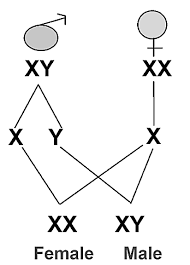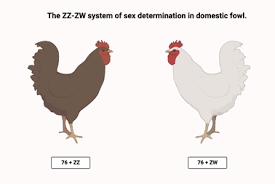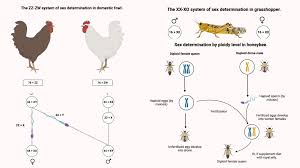Within a population, sexual reproduction enhances genetic diversity because the genetic material of offspring comes from two sources. For most species of animals and some species of plants, sexual reproduction is carried out by individuals of the opposite sex females and males.
The underlying mechanism by which an individual develops into a female or a male is called sex determination. Various mechanisms promote this process.
For some species, females and males differ in their genomes. For example, humans differ with regard to X and Y chromosomes. Females are XX and males are XY, meaning females have two copies of the X chromosome, whereas males have one X and one Y chromosome.
Because these chromosomes carry different genes, chromosomal differences between the sexes result in unique phenotypes and inheritance patterns.
Read Also: The Alfalfa Petals: Economic Importance, Uses, and By-Products
Common Mechanisms of Sex Determination

Researchers have studied the process of sex determination in a wide range of species and discovered several different mechanisms. Sex determination in some species is due to the presence of specific chromosomes. A pair of chromosomes, called the sex chromosomes, determines sex in many different species. Some examples include:
1. X-Y System of Sex Determination: In the X-Y system, which operates in mammals, the male contains one X chromosome and one Y chromosome, whereas the female contains two X chromosomes. The male is called the heterogametic sex, producing two types of sperm—one carrying the X chromosome and another carrying the Y.
The female is the homogametic sex because all eggs carry a single X chromosome. The sex of the offspring is determined by whether the sperm that fertilizes the egg carries an X or a Y chromosome.
In mammals, the Y chromosome promotes male development. The presence of a gene on the Y chromosome called the SRY gene causes maleness.
2. X-0 System of Sex Determination: This mechanism operates in many insects. In some insect species, the male has only one sex chromosome (X) and is designated X0, whereas the female has a pair (XX). In other insect species, such as Drosophila melanogaster, the male is XY. For these species, the ratio between X chromosomes and the number of autosomal sets determines sex.
Read Also: The Appearance and Features of Tilapia Fish
3. Z-W System of Sex Determination: This system determines sex in birds and some fish. In this case, the male is ZZ and the female is ZW. The letters Z and W distinguish these types of sex chromosomes from those found in the X-Y pattern of sex determination in other species. In the Z-W system, the male is the homogametic sex, and the female is the heterogametic sex.

4. SRY System of Sex Determination in Mammals
It is often stated that sex determination in humans is based on the presence or absence of the Y chromosome. However, the situation is more complex.
Sex determination in humans and other mammals is due to a single gene that is normally located on the Y chromosome in a region called the sex-determining region (SRY).
The SRY gene produces a protein called Testis-Determining Factor (TDF), which stimulates undifferentiated gonadal tissue in embryos to form testes. The gene functions early in the developmental stages of the embryo, ultimately causing tissue that would have developed into ovaries to switch and form testes instead. Individuals without this gene develop as females.
In some cases, the SRY gene may become associated with a chromosome other than the Y. This can result in individuals with an XY chromosome complement developing as normal females, or individuals with an XX chromosome complement developing as normal males.
Therefore, it is not the Y chromosome itself that determines maleness, nor the presence of two X chromosomes that determines femaleness; rather, it is the presence or absence of the protein coded by the SRY gene that determines gender in mammals.
The earlier perception of sex determination in mammals using the XY system was revised with the discovery of the SRY system. It is now understood that sex determination in humans and other mammals is primarily due to a single gene located on the Y chromosome, in a region called the sex-determining region (SRY). The SRY gene produces Testis-Determining Factor (TDF), which stimulates undifferentiated gonadal tissue in embryos to form testes.
Do you have any questions, suggestions, or contributions? If so, please feel free to use the comment box below to share your thoughts. We also encourage you to kindly share this information with others who might benefit from it. Since we can’t reach everyone at once, we truly appreciate your help in spreading the word. Thank you so much for your support and for sharing!

